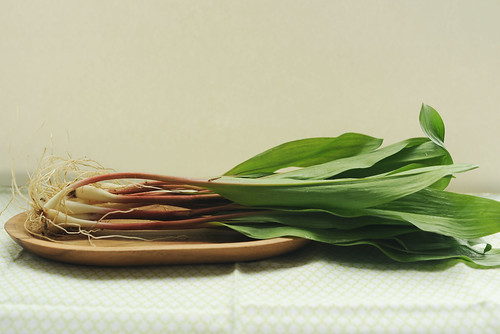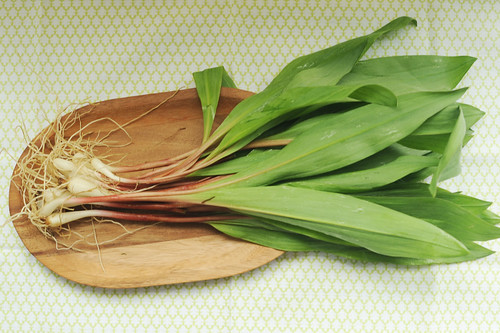And this is where my mind drew a blank. Not only did I not consider that ramps weren’t part of our Russian diet, I didn’t know the Russian word for it. And trying to explain an unknown ingredient to someone is a challenge – no matter what vocabulary you use, you still fall woefully short of the actual thing. To know an ingredient, you have to taste it.
Normally, I’m much more on top of English-to-Russian translations of produce. I often discuss food with my parents, pick their brain on how we would cook something in Russia, so it’s not uncommon for us to talk about sorrel, nettles, chanterelles, among a few. Somehow, I failed to consider that, in fact, there is no Russian word for “ramps” because ramps are not native to Russia.
The closest relative, so to speak, is wild garlic known as “cheremsha” which grows for a few short weeks in the spring and, due to its short season, is normally pickled. My parents introduced me to it a few years ago, when they came to visit and brought with them a few Russian deli provisions, pickled cheremsha among them. It quickly became my favorite snack and replaced the less-than-exciting celery in my Sunday Bloody Mary.
Ramps are, obviously, not cheremsha, but I also find them an excellent candidate for pickling. In fact, it is my favorite way of eating them, and it extends my ramp-enjoying season, so to speak. After they’re ready, I throw them in a martini, or periodically fish them out of the jar, whenever I’m hankering for a snack. Lately, I’ve been hiding them in a layer of thick, creamy ricotta slathered over rustic sourdough bread. And last year, over at one of my favorite restaurants, Hearth, pickled ramps were served alongside salty, briny mackerel.
Best part is that you don’t have to wait too long to taste your creation – the pickling process takes about two days and stores for months and months refrigerated. Though I don’t think that our batch will survive the spring. Which is too bad, because I sure would have loved to share some ramps with my parents – so they could finally learn not only their meaning, but their unforgettable flavor.
Pickled Ramps
Adapted from the Gramercy Tavern via Natural Health Magazine
Cleaning ramps is probably the worst part of the whole process. They get muddy and sandy and you want to be really careful with getting all that grit out – believe me, it doesn’t taste great. After your ramps are clean, you want to separate out the greens from the white parts. You’ll pickle the lower parts, but by no means throw out the greens out – they make a wonderful addition to pastas, wilted for a few minutes in a pan with a little garlic and dissolved anchovy. Also, keep in mind, that when all is said and done, those white parts are tiny and your pickled ramp amount will most likely be small. This means you need to buy a lot of ramps. Which means you probably need to shell out a lot of money. Which is not something I am in favor of doing especially given the precarious state of the economy. However, if you use these ramps are your martini garnish, unless you have a martini-a-day habit (nothing wrong with it), these ramps might last you awhile. Which means, you could stretch the cost quite far. But still – cheap they are not. And if there’s an area near you where wild ramps grow free, go forth and capitalize on this mighty bounty. It’ll be well worth it.
Ingredients:
1/2 pound ramps, cleaned, green leaves removed
1/2 cups white wine vinegar
1/4 cup water
1/4 cup demerara sugar
1 garlic clove
1/8 teaspoon fennel seeds
1/8 teaspoon coriander seeds
1/8 teaspoon mustard seeds
1/8 teaspoon whole black peppercorns
1/8 teaspoon hot chili flakes
1 sprig thyme
1/4 teaspoon coarse kosher salt
Preparation:
1. Bring a large pot of water to boil and blanch ramps, about 1 minute.
2. Chill ramps in an ice bath. Drain.
3. Add remaining ingredients to a pot, bring to a boil then simmer for 10 minutes. Allow time for liquid to cool completely.
4. Pour cooled pickling liquid over ramps and store in a container with a tight lid. They will be ready to eat in two days and can be stored, tightly sealed, in the refrigerator for months.


